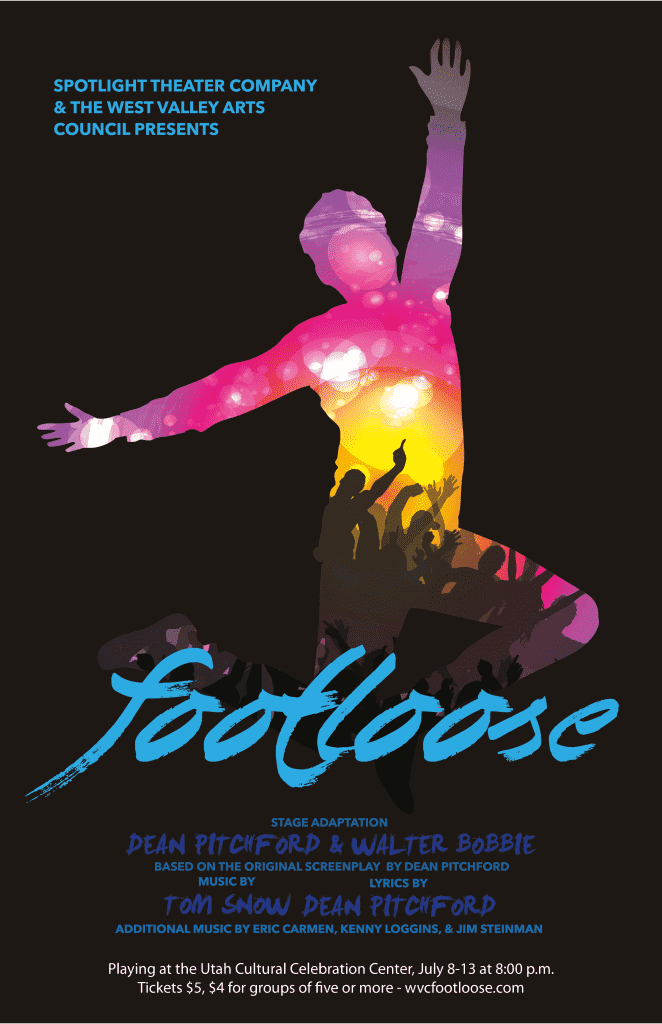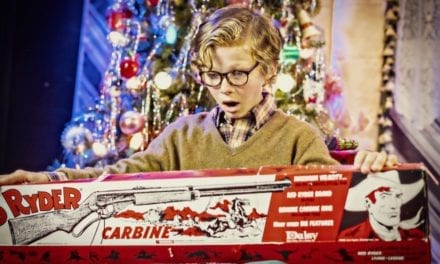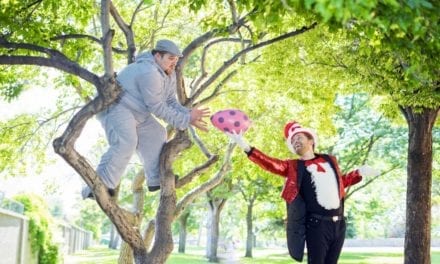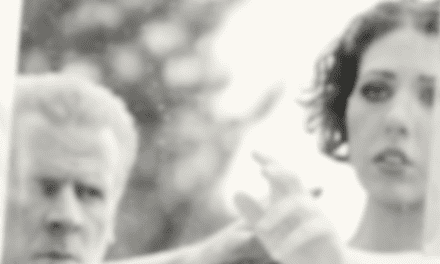WEST VALLEY CITY — From its mid-1980’s beginning as a major motion picture to its late 1990’s transition to the musical theatre stage, Footloose has presented its themes of growth and redemption to the beat of a rock combo orchestra. Ren McCormack’s (Brock Dalgleish) story starts in Chicago but moves quickly to the middle-of-nowhere town of Bomont where he and his mother, Ethel (Emily Ferrin), begin a new life without Ren’s father. As Ren works to find his place in Bomont, a small town in which no dancing is allowed for fear of its evil influence on the town’s young people, he finds him mixed up with Ariel Moore (Karllen McDonald), the fiesty preacher’s daughter. Reverend Shaw Moore (David Weekes) approves no more of Ren’s association with his daughter than he does of Ren’s petition to legalize dancing within Bomont’s city limits. But the reverend isn’t the only character in need of some painful growth. Ren’s awkward friend Willard Hewitt (Lucas Charon) learns to dance to please his girl Rusty (Aimee Smith). Ariel stops chasing the town’s bad boy, Chuck Cranston (Harrison Lind) as she searches for a real hero. Finally, the mothers in the story, Vi Moore (Michelle Critchfield) and Ethel McCormack, both discover how to express themselves honestly in their families. Ultimately, a forceful heart to heart between Ren and the reverend results in a much needed beginning to Bomont’s healing and permission to hold the first dance in years.
This Spotlight Theater Company production presented by the West Valley Arts Council was in most ways a success. However, as riddled as it was with technical weaknesses, it lacked the momentum to become a real hit. Having seen Footloose on its opening night, I hope there will still be opportunities for technical director Isaac Taylor to make the needed adjustments to both sound and lighting to improve the rest of the run. Several microphones were off for large portions of the show including Chuck’s microphone during most of “The Girl Gets Around” and Ren’s microphone during the entirety of “Almost Paradise” and his speech to the town council. Rev. Moore’s microphone cut repeatedly in and out during a pivotal scene with Vi, disrupting the emotion Weekes and Critchfield had created. Equally distracting was the sporadic use of a single spotlight frequently attempting to light simultaneous but physically separated action on the stage. The result was often an actor or actress left in the dark, as was the case in “Almost Paradise” as the spotlight attempted to chase both Ariel and Ren. In addition, the spot color was designed to change from white to red or blue at various points in the production; however, this transition tended to happen abruptly during static moments in the scenes, such as at the beginning of Rev. Moore and Vi’s final scene in which the spotlight turned on after the scene had already begun and then turned quickly to blue a number of seconds later. Additional lighting choices, including lights which flickered to the beat during “Mama Says” did not enhance the movement on the stage.
The costumes, designed by Chelsea Sloan, indicated a time period anywhere between the 1980’s and the present day with conflicting pieces on stage at the same time. While I enjoyed the diversity of 1980’s attire in the opening number, “Footloose,” the transition to Bomont worship attire seemed a hodge-podge of nineties fashion not particular to any one style. The gym clothes worn by high school students in “I’m Free” ranged from second-hand duds to cut off sweat pants to shorts straight off today’s basketball courts. Although current styles borrow heavily from 1980’s fashion, many of the prom-style dresses worn in the final rendition of “Footloose” reflected the contemporary changes to the length and style of today’s formal wear. This was especially true of Ariel’s too-short white formal which frequently revealed her white biker shorts during the final dance sequences.
Unfortunately for director Brighton Sloan, I had to look past these distracting elements to see the show’s many successes. Fortunately for me, I didn’t have to look very far. The greatest strength of this production was definitely choreography by Sara Flitton and Brittany Bowman. The musical score features several large dance breaks in numbers like “Footloose,” “I Can’t Stand Still,” and “Still Rockin’,” and each dance break provided something unexpectedly delightful. Female members of the teen ensemble reacted with natural surprise at being included in “I Can’t Stand Still,” and male members used their impressive strength to execute the many lifts used in the choreography. Most surprising was when one teen ensemble member flew high above the rest of the cast, tossed by her cast mates in the finale version of “Footloose.” The only major disappointment was the decision to stage almost all of “The Girl Gets Around” in the aisle behind the audience.
A close second was the small ensemble singing, perfected through Gary Sorenson‘s music direction. Ariel’s trio of friends, Rusty, Urleen (Linda Smith), and Wendy Jo (Ali Fisher) delivered powerful and balanced harmonies in their many songs of the evening including “Somebody’s Eyes.” Ferrin, Critchfield, and McDonald blended their individual angst into beautiful three-part harmony in “Learning to be Silent.” But Willard’s backup boys, Bickle (Carter Walker), Garvin (Harrison Young), Jeter (Ryan Stuart), and Shalalynn (Asher Smith), delivered the tightest chords of the evening, somehow turning their backup strains of “Mama Says” into a smooth dissonance reminiscent of 1950’s crooners. I have never been so glad to have a number reprised.
Each song played by the seven-member orchestra sounded so effortless, it would be easy to forget the music was played live at all. Under conductor Craig Ferrin, the song tempos seemed to drive the energy in each of the dance numbers, and Doug Clyde’s woodwinds aptly underscored many of the emotionally laden scenes. Although the balance of vocals to orchestra was not ideal, with the orchestra frequently louder than small and large ensembles alike, this seemed to have more to do with microphones and staging. At the end of “I’m Free/Heaven Help Me,” the entire cast stood near the front of the stage to sing the final complex chord, which mixed in the air just above the orchestra pit and rang out with perfect balance. However, when the cast was blocked more to the rear of the stage, the notes dissipated before reaching the audience.
It was also easy to notice the strengths of individual leading actors and actresses. Dalgleish’s athletic dancing was a perfect fit for a guy who just can’t sit still. Smith’s portrayal of the fast-talking Rusty believably left Willard stunned. Charon delivered Willard’s scripted lines (and plenty of in-character ad libs) with impeccable comedic timing, eliciting my laugh almost every time. Rev. Moore’s solos including “I Confess,” showcased Weekes’ strong, easy tone along with his reflective characterization. Even Cowboy Bob (Jeff Kinsel) who makes his appearance only for the opening scene of Act II left a lasting impression with his skillful and energetic delivery of “Still Rockin.” While many of the cast seemed strongest in singing and dancing, the acting became more convincing as the show went on. By the second act, characters that had seemed earlier to be affecting distant emotions finally internalized them, making later interactions between members of the Moore family and interactions between Ariel and Ren more sincere.
What appeared on the surface to be a bit of a technological mess was actually a hit production waiting to emerge. Backed by strong choreography, solid harmonies, and a non-stop rocking orchestra, this Footloose cast is putting their individual talents to collective good use. Whether you’re a Footloose fanatic or ready to dance for the first time, take a chance on this production. You won’t have to look far to find something to love.






